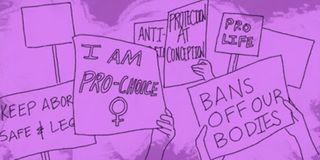When US outlawed abortion

What you need to know:
The court declared that the constitutional right to abortion, upheld since 1973, no longer exists
On Friday June 24, 2022, the Supreme Court of the US, in a historic and far-reaching decision, by a vote of six to three, overturned a landmark case whose ruling was the basis for establishing a constitutional right to abortion.
Ruling
The court declared that the constitutional right to abortion, upheld since 1973, no longer exists. This decision for practical purposes means that abortion will no longer be available in many parts of the country and more restrictions are likely to follow as the individual states enact laws to further restrict abortion. States are now apparently completely free to ban abortions for any reason.
Dissent
The three judges who dissented were all appointed during the reign of the Democrats while the six judges were appointed by Republican Presidents of the United States.
The three judges said that the court decision means that the young American woman today will come of age with fewer rights than their mothers and grandmothers. Indeed they said the court’s opinion means that from the very moment of fertilisation, a woman has no rights to speak of.
A state can force her to bring a pregnancy to term even at the steepest personal and familial costs. “With sorrow for this court, but more for the millions of American women who have today lost a fundamental constitutional protection, we dissent,” they wrote.
Abortion law
In 1969 a 25-year-old single woman, pregnant with her third child, challenged the criminal abortion laws in Texas that forbade abortion as unconstitutional except in cases where the mother’s life was in danger.
She claimed that she had been raped but the case was rejected and she was forced to give birth. However, in 1973 her appeal made it to the US Supreme Court. By a vote of seven to two, the judges ruled that governments (states) lacked the power to prohibit abortions.
Judgment in 1973
The court’s judgment in 1973 was based on the decision that a woman’s right to terminate her pregnancy came under the freedom of personal choice in family matters as protected by the 14th Amendment of the US Constitution; that the “Due Process Clause” of the Fourteenth Amendment of the Constitution of the USA protects a woman’s right to have an abortion prior to viability. The majority of judges held that women had a privacy interest protecting their right to abortion in the Liberty Clause.
The judge who wrote the lead judgment overturning the decision of the Supreme decision of 1973 described that the decision as egregiously wrong, the arguments exceptionally weak and so damaging that they amounted to an abuse of judicial authority.
Inherent right to privacy
This, to the judge, is because there is no inherent right to privacy or personal autonomy in the various provisions of the Constitution. “We hold,” he wrote, “that the Constitution does not confer a right to abortion”
The judge also ruled that any state regulation of abortion is presumptively valid and must be sustained if there is a rational basis that the law is serving legitimate state interests including respect for and preservation of prenatal life at all stages of development.
In addition he noted that states are entitled to regulate abortion to eliminate gruesome and barbaric medical procedures and also to preserve the integrity of the medical profession and to prevent discrimination on the basis of race, sex, or disability, including barring abortion on cases of fatal abnormality.
The judge emphasised that this decision only concerned the constitutional right to abortion and no other right and that nothing in the judgment should be understood to cast doubt on precedents that do not concern abortion.
However another judge went further and said that the legal rational for outlawing abortions could be applied to overturn other major cases, including those that legalised gay marriage, barred the criminalisation of consensual homosexual conduct, and protected the rights of married people to have access to contraception.
Precedents
To the judge in future cases courts would have to reconsider all these precedents because they are demonstrably erroneous.
Several states in the US have decades-old abortion bans in their statutes. In recent years, many states have passed laws prohibiting abortion at various stages of abortion. Courts have blocked many of these laws in response to legal challenges and the courts referred to the 1973 Supreme Court ruling to block these laws.
A host of other restrictions could limit where, by whom, and under what conditions abortion can be provided.
Some examples include laws requiring parental notification or consent for abortions involving patients who are minors. Legal experts say the court’s decision will pose new questions for other courts to deal with, especially about how to apply the specific language of the final ruling to individual state laws. Some legal experts predict far more litigation and legal chaos in the federal courts across the country in the immediate aftermath of the decision.
Some state constitutions may offer protections for abortion rights notwithstanding the Supreme Court’s interpretation of the Constitution. Fundamental to these are the privacy rights protections guaranteed in some state constitutions.
There is no doubt that the abortion question has been a focal point in the midterm elections. A law professor has predicted that the next time the Republicans win control of the Senate and White House and the House of Representatives a national abortion ban is going to be on table.




